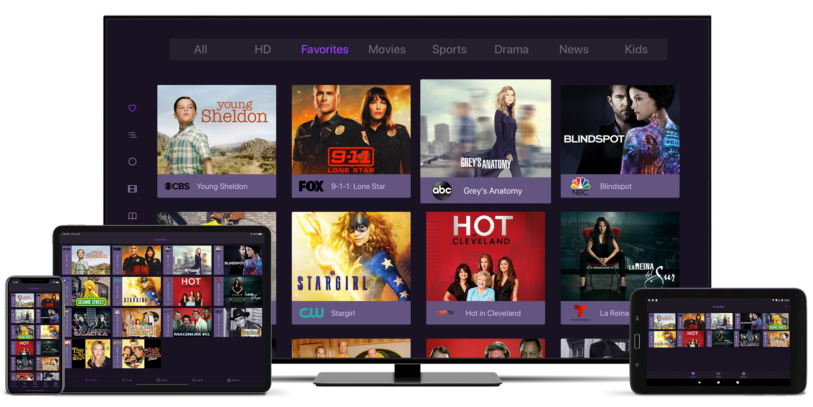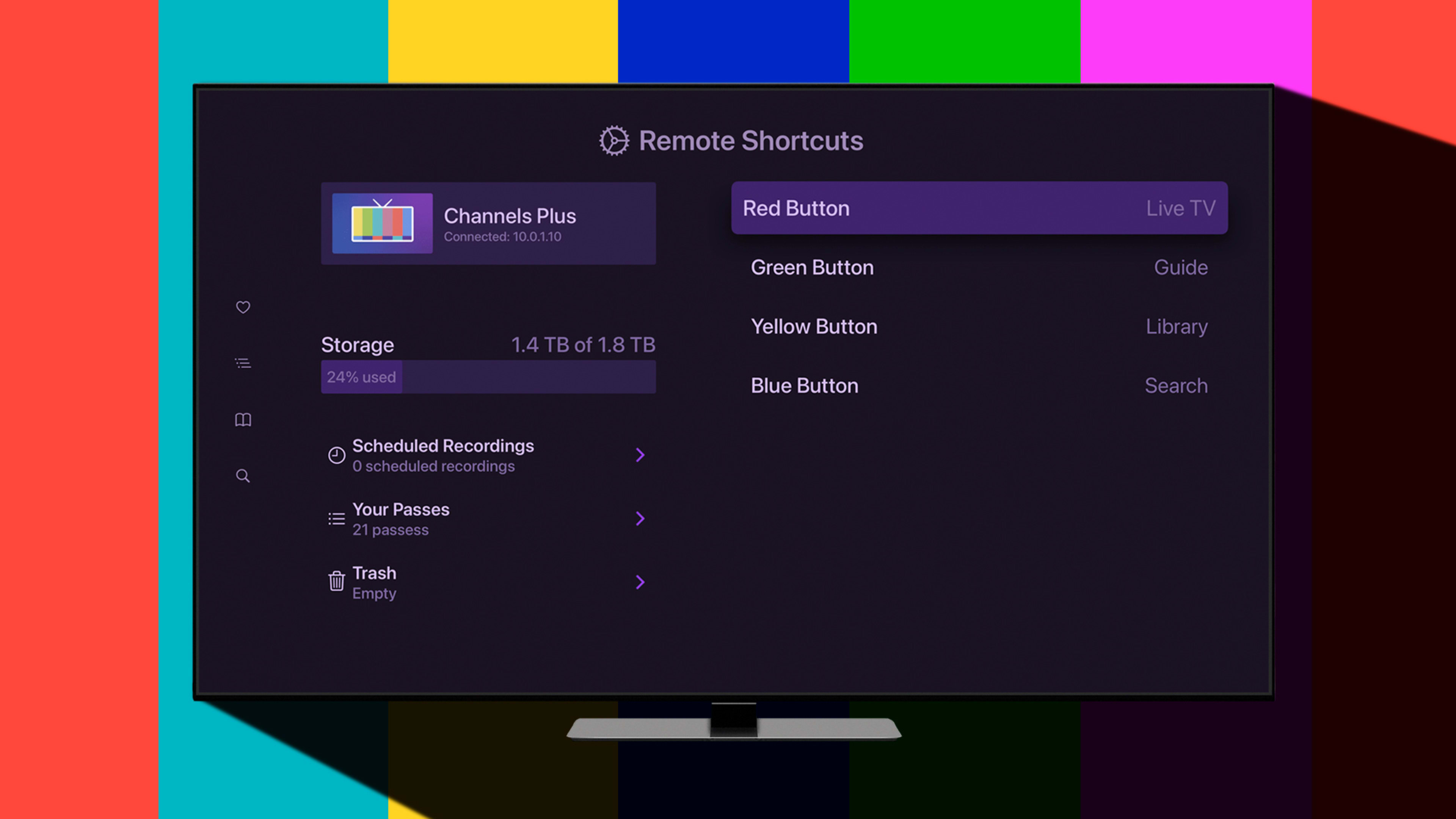The rise of cord cutting and streaming video was supposed to render the digital video recorder (DVR) irrelevant. In theory, you shouldn’t need to record anything when services like Netflix and Amazon Prime make everything available on demand.
But now that every big media company has its own streaming service, all that instant gratification has come at a cost. Watching TV now means bouncing between a dozen different apps, each with its own separate menu system, catalog, and watch list. Say what you will about the stodginess of cable, at least it put everything in one place.
That’s why a tiny company called Fancy Bits, founded by a pair of former GitHub employees, is bringing the DVR back. The company’s $8 per month Channels service takes video from a wide range of sources—online cable channel feeds, live-streaming apps, over-the-air broadcasts, and even on-demand services like Netflix—and pulls it all into one menu. It does this primarily by letting users create their own personal copies of the content, just like an old-school DVR.

“It’s funny, right? Because what we’re building towards is something that was sort of built 20 years ago,” says Jon Maddox, one of Fancy Bits’ cofounders. “Really, we’re just trying to make this single place for people to go watch their TV that everybody is looking for.”
‘Kind of like Legos’
Setting up a Channels DVR is an admittedly nerdy endeavor, similar to configuring media center applications like Plex or Emby. Users install Channels on a server device, which can be a desktop computer, a network-attached storage device, an Nvidia Shield TV streaming box, or a Raspberry Pi mini-PC. Video then streams over Wi-Fi to Channels’ viewer apps on Fire TV, Apple TV, Android TV, iOS, and Android.
Channels’ creators are serious about making the app simple and dependable once it’s up and running.
Last month, Channels also introduced a tie-in with PlayOn, a long-running service for recording video from on-demand sources such as Netflix, Amazon Prime, and Disney+. Users can set up recordings through PlayOn’s mobile app, and once they’re complete, Channels can automatically download the video to watch through its own DVR apps.

“You still have knobs you can tweak,” Karmani says. “It feels kind of like Legos.”
At the same time, Channels’ creators are serious about making the app simple and dependable once it’s up and running. The software takes cues from traditional DVRs like TiVo, with features like series recordings, team passes for sports, and the ability to time shift any live program. It also nails a lot of the little touches that made traditional DVR so pleasant, like progress indicators for shows you’re currently watching and a list of recently recorded programs. It can also detect commercial breaks and skip over them automatically.
“The best compliment we get is when people say that their family loves it,” Karmani says. “Because how many families love their media center solutions? None of them.”
Hobbyist roots
For years, Channels was just a side project for Maddox and Karmani, who were both among GitHub’s earliest employees. On nights and weekends, they started off collaborating on media server software, but they moved onto live TV after discovering HDHomeRun, a line of devices that can stream live TV from an antenna or CableCARD to other devices around the house.
When Apple released its third-generation Apple TV, Maddox and Karmani started working on HDHomeRun support, but because that device had no app store, the best they could do was rely on a hack that made their videos show up inside Apple’s Trailers app. The fourth-generation Apple TV, however, was a breakthrough, allowing them to stream video natively from HDHomeRun tuners. And for the first time, they could actually sell their software; the first version of Channels hit the App Store in November 2015.
“Getting it to run on a platform that was built with an app store, all of a sudden it was like, ‘Hey, this could be a thing,'” Maddox says.

The calculation changed as GitHub ballooned in size, eventually getting acquired by Microsoft in 2018. While Maddox and Karmani say they both enjoyed working at GitHub, neither of them wanted to work at a large company. Karmani had already left before the acquisition, and while Maddox had been less certain about whether to stay, they both convinced one another to turn Channels into a full-time job in early 2019.
Channels won’t say exactly how many users it has, but Maddox says the number is in the “thousands,” and that their decision to work on it full-time was the right one.
“It was honestly this or stay at GitHub,” he says. “But it was tough for me to not pursue this, because, holy cow, we’re making money on a hobby.”
Rethinking the DVR
Post-GitHub, Channels seems to have taken on a renewed purpose. Instead of just relying on CableCARDs and antennas, it now pulls in video from live and on-demand streaming sources. That in turn makes it more like a universal DVR, rather than just an alternative app for HDHomeRun enthusiasts.
“We’re at a point now that what customers are demanding is essentially cable,” Maddox says. “They’re tired of segmented content and disparities all over the place, using apps that have different browse flows, and different watch lists, and all of that. They want one place.”
Still, modern streaming platforms are unlikely to come up with a perfect solution on their own. Google, for instance, is trying to build a unified menu system through its Google TV platform, yet it recently lost a big chunk of its Netflix integration, and support for features like its “Continue Watching” row can vary by service. Apple’s unified “TV” guide doesn’t integrate with Netflix either, and Amazon’s Fire TV devices offer no easy way to resume watching shows from across different services.

This desire leaves streamers wanting to send people into their individual apps whenever possible. “That way they get to present content the way they want to, and are more likely to get your next hour, not just your first one,” Greengart says.
Channels, then, is a way for consumers to take back some control. Once the DVR makes a recording, users can keep it for as long as they want and use it however they please, and the integration with PlayOn means users can bring in on-demand sources like Netflix. They never have to worry about streaming services dropping their favorite movies or shows, and the amount of video they can keep is only limited by the size of their hard drives.
“People have an ownership over this with Channels, I think,” Maddox says. “They feel like it’s theirs. They can do stuff with their own content.”
Staying nerdy
All of this unapproved recording does get into some murky territory—if not legally than at least from a terms-of-service perspective. While legal protection for personal recordings dates back to the 1980s with the Betamax case, streaming services generally don’t allow users to make copies of their content.
Aman Karmani, cocreator, ChannelsThe idea of sitting in meetings with a bunch of execs at Peacock is not going to be appealing, because we know it’s not going to be productive.”
“We’ve never been challenged, because it’s likely that they would lose, and they don’t want to lose,” Burman says.
Likewise, Fancy Bits takes its own steps to avoid running afoul of copyright law with Channels. Users who connect their pay TV service only get the channels they’re entitled to watch, and aren’t allowed to record from pirated content sources.
To some extent, services like Channels may also avoid scrutiny by staying small. Maddox and Karmani have no big plans for marketing Channels other than by word of mouth, and they consider themselves a small business rather than a startup looking for an exit. They even seem unenthused about the idea of making their service easier to set up through pre-built hardware—say, a plug-and-play networkable box with its own storage and Channels’ server built in.
“All of a sudden you’re talking about inventory, and logistics, and shipping,” Karmani says. “We just don’t know anything about that or feel like it’s a good use of our time.”
The same goes with reaching out directly to streaming services, in hopes of integrating their content. Karmani says they’ve never tried, and probably never will.
“The idea of sitting in meetings with a bunch of execs at Peacock is not going to be appealing, because we know it’s not going to be productive for us, and it’s not going to be fun for us,” he says.
The future of Channels, then, is to keep doing what it’s always done. That means appealing to people who don’t mind tinkering a little bit, and giving them a long-lost way to centralize all their content. Because for the most part, no one else will.
“We’ve really enjoyed building this piece of software that’s bridging that past and the future,” Maddox says.
Sign up for Jared’s Cord Cutter Weekly newsletter for more news, tips, and insights on cutting cable or satellite TV.
Recognize your brand’s excellence by applying to this year’s Brands That Matter Awards before the early-rate deadline, May 3.
